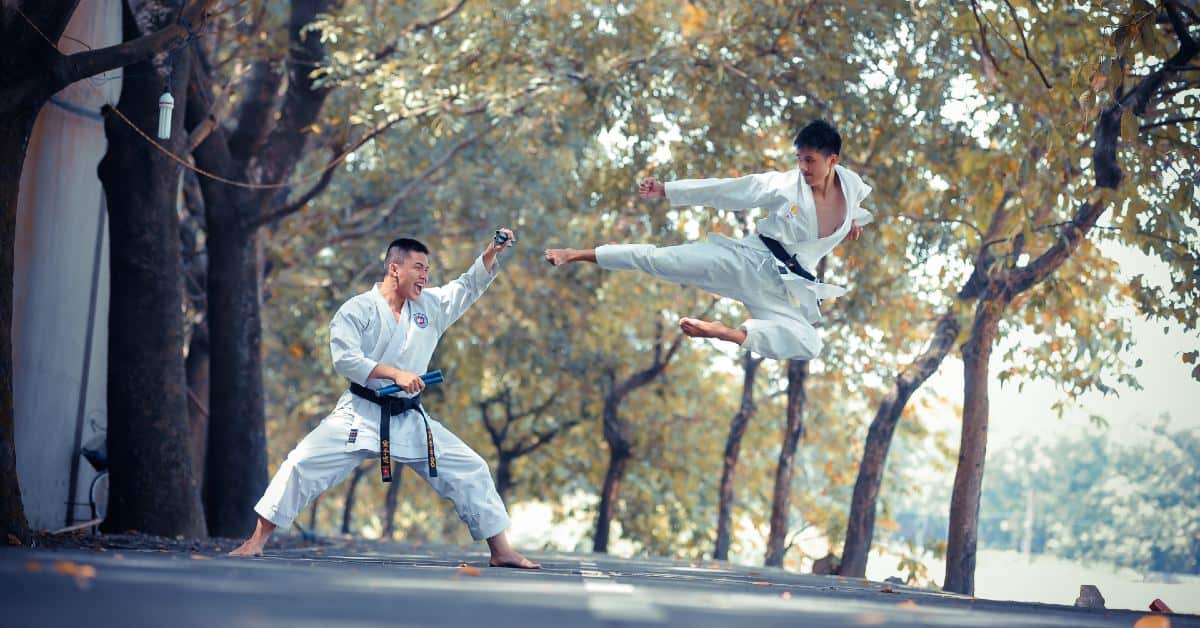Karate is one of the most popular Martial arts in the world. Originated in Japan, Karate has developed from being a military-based skill to the sport we know today. Nowadays, it isn’t exactly what it was in its beginnings, especially when it comes to combat. Tournaments use the point fighting system instead of free, full-contact sparring for obvious reasons. But, what is Karate Point Fighting in the first place?
Karate Point Fighting is a certain type of combat in Karate, where the goal isn’t to incapacitate the opponent but to score the most points. Rules are strictly determined, and it requires a lot of technique, quickness, patience, and balance to win a Karate Point Fighting bout.
Because of the semi-contact nature of Karate Point Fighting, a lot of people think that the techniques displayed here aren’t effective at all for self-defense or real combat. But, there are different types of battles in Karate, and there are still competitions held that allow full contact, free sparring. If anything, Karate Point Fighting requires a lot more discipline and precision.
Evolution of Karate
Karate, like many other ancient Asian martial arts, has its roots deep into history. It stems back to the first martial arts developed in that area. Shaolin monks in Ancient China developed the first systems of training that included meditation and self-defense drills. After the Shaolin temple was destroyed, monks that survived scattered across China, where they taught others their skills in martial arts.
Meanwhile in Okinawa – an island in Japan – owning any sort of weapons was forbidden, unless you are in the direct service of Hanoshi, the ruling shogun of the Sho dynasty. So, people had to find other ways to defend themselves. Geographically, Shanghai was much closer to the Okinawans than Kyoto – the capital of Japan at the time – so they traveled to China to practice martial arts.
When returning to Okinawa, they started teaching others what they have learned while implementing new elements. That way, the ancient martial art called Te was developed (meaning “hand” in Japanese).
Later, Te started to spread across Japan and further when they realized that soldiers from Okinawa were in pristine physical and mental condition. The emperor called upon the Okinawan martial artists to demonstrate their craft publicly. so, Gichin Funakoshi has done the demonstration, and the rest is history.
He changed the name from Te to Karate (meaning “empty hand”) and is known today as the father of modern Karate.
Modern Karate is divided into three types, segments, or disciplines: Kihon, Kata, and Kumite. Only the third, Kumite, is fighting between two opponents, and that too has different types.
Kumite
Encapsulating both Kihon and Kata, Kumite is the fighting segment of Karate. Practitioners learn a huge variety of moves, both for full contact and semi-contact Karate – which is the one used in Karate Point Fighting. Now, if we are talking about Karate as a martial art, we can divide it between Budo Karate and Sport Karate.
Budo Karate is self-defense Karate, and this is the one that can save your life if need be. When practicing Budo Karate, you are in a mental state where you “fight to survive”. You’ll learn how to incapacitate your opponent with full contact, disregarding injury, or rules.
Sport Karate, on the other hand, is what you can learn in any Karate Club today. You learn the basic techniques, but you prepare for combat under rules, and almost all the competitions are point-based. Let’s get a bit deeper into it.
What is Karate Point Fighting?
Kumite, or battle Karate, has 4 major types. Jiyu Kumite is a free fight, usually practiced only in a gym (dojo). Kiso Kumite is a structured, choreographed bout developed from Kata. Sanbon Kumite is a three-step battle, used to develop strength, speed, and technique. The last one, Ippon Kumite, is the one regularly used in Karate Point Fighting.
In Karate Point Fighting, there is a strict rule set into which strike gets you points, which strikes are forbidden, etc. The biggest and most significant competitions are Karate World Championships, organized by the World Karate Federation (WKF).
The winner has to take an 8-point lead over the opponent for the bout to be ended. If the set time-frame has expired, the winner will be the fighter who scored the most points up to that point. If the results are tied, the winner can be decided in different, pre-determined ways. Either they fight for a “golden point” – the first one to score wins – or additional time is set to complete the bout.
After every point is scored, the bout is paused and reset to the middle of the tatami (combat area).
Karate Point Fighting Scoring and Penalties
You can score one, two, or three points in a Karate Point Fighting bout. According to the World Karate Federation, there is Yuko (A) and Yuko (B), worth 1 point, Wazari, worth two points, and Ippon (A) and Ippon (B), worth three points each.
Yuko (A) and Yuko (B)
Yuko (A) is a straight punch directly delivered to the body of the opponent. It has to be clear and not blocked to count and will get you one point. It is a safe strategy to play, however, it is blocked very frequently, because you have to cut the distance between you and your opponent to get inside for the jab, which gives them time to pull back or even counter.
Also worth one point, Yuko (B) is a straight punch delivered right to the face. However, it can be very tricky to use this technique, because any unnecessary contact is usually penalized in competition. Some tournaments even forbid this move.
Wazari
Wazari is a leg technique – a middle kick to the body worth two points. It has to be clear and not blocked, and it is allowed to land in the abdomen, back, chest, or sides, depending on the position of your opponent. Shoulder strikes, arms strikes, and strikes below the waist are considered blocks, therefore they do not get you points.
Ippon (A) and Ippon (B)
The techniques worth the most points are the ones that are the hardest to execute. Ippon (A) is a kick delivered to the head. It counts as three points if delivered to the face, head, and even neck. However, you need to be careful not to hit the throat, as it is forbidden and can lead to disqualification.
All kinds of kicks are allowed, including straight front kicks, roundhouse kicks, and other techniques. They are performed with the base of the foot instead of the shin (as many martial arts suggest) to ensure balance and to avoid unnecessary contact.
Ippon (B) is also worth three points, and you can get them by any strike that counts as scoring, but while the opponent is on the ground. Sweeps, grabs, and grapples are allowed to take down the opponent, but not to continue the fight on the ground.
It is essential to be of pristine fitness, because the competitions can last a while, and you can have several bouts on the same day. That is why Karate fighters also learn how to stay focused and in control, as it is a lot easier to get penalized in a fight than to score.
Karate Point Fighting Penalties
Penalties in Karate Point Fighting are given gradually or explicitly, depending on the severity of an infraction or misconduct. There are two categories of prohibited conduct in a match.
Category 1 is more based on the interaction with the opponent, such as prohibited techniques and strikes. Also, attacks to the arms, legs, joints, and groin are strictly forbidden, along with any sort of an attack to the face with an opened hand.
Category 2 is based more on individual behavior, conduct, and sportsmanship. For instance, exaggerating injury is a category 2 penalty, because it’s considered not to be fair play. Exiting the combat area also isn’t allowed without the opponent causing it. Also, to avoid “scorekeeping”, participants must engage in combat at all times, because passivity is prohibited as well. You ought not to taunt your opponent, and have to obey the orders a referee gives you.
Violation of both category 1 and category 2 prohibitions are penalized, first with warnings, and then with penalties. Some competitions fine the participants with point reductions, but disqualification penalties are much more often.
Chukoku is the first warning, given for a minor violation of the rules, such as accidental leg strikes, pulls, etc. If the fighter continues to violate the same category ruleset, he/she will be given a Keikoku. Hansoku-Chui is the third and final warning before disqualification. It can be given due to repeating the same violation several times, or if a violation is more severe. For instance, a strike after the referee stopped the bout for a reset.
Finally, the most severe violations are penalized by Hansoku, or disqualification from the bout. Unnecessary contact or repeated violations can lead to the fighter’s score getting reduced to zero and the opponent’s set to 8, automatically meaning victory.
If a violation is considered extreme or unsportsmanlike, it can get the offender a Shikkaku, or disqualification not only from that particular bout but from the entire tournament.
From the structured discipline of point fighting to the selection of the right equipment, every facet of Karate demands meticulous attention. That’s why, we can’t emphasize enough, the importance of selecting the right equipment to complement your martial arts journey. If you want to elevate your karate experience even further, then finding the best Karate Gi can be transformative. Be it for enduring rigorous training sessions, or looking your best for a competition, the choice of the Gi can add immense value to your Karate practice.

